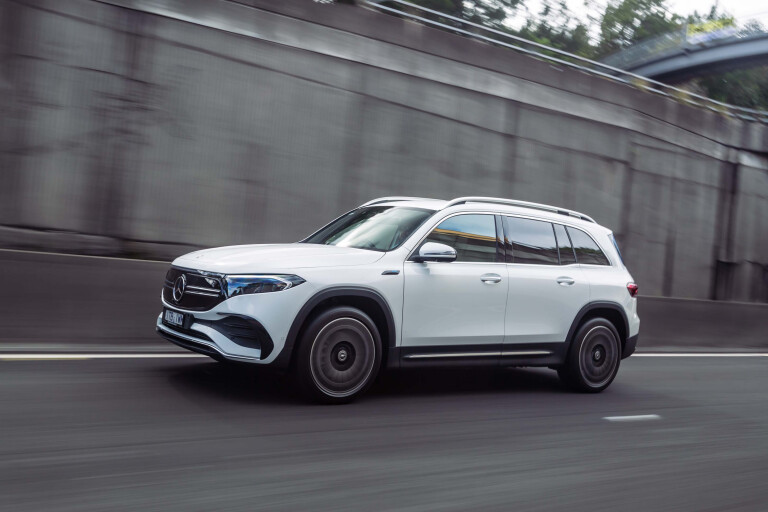
Score breakdown
Things we like
- The only 7-seat electric car you can buy
- Comfortable ride & polished dynamics
- Superior to drive than the GLB on which it’s based
Not so much
- More expensive, slower and has less range than rivals
- 5 seat versions lose sliding second row
- Sub-par cabin plastics & no electric seats feel stingy at this price
Here’s the problem: you want an electric SUV but you also need the room and practicality of seven seats. Not exactly spoilt for choice, are you?
The Tesla Model X filled the gap for a while, but there’s still no word on when the fresh 2022 version will actually arrive in Australia.
The last time a Tesla Model X was sold here was way back in early 2021.
Now, though, Mercedes-Benz has entered the fray. This is the EQB, and it’s the third electric SUV Mercedes has launched in Australia following on from the EQC and EQA.
Just like those cars, it isn’t a bespoke EV (we’ll have to wait for the arrival of the just revealed EQE SUV and EQS SUV to reap the benefits of an EV-first platform) but rather it’s an electrified version of the existing GLB, meaning it shares the same MFA2 underpinnings, basic dimensions and the option of three rows of seats.
The extra pews are a $2900 option, mind, and when you line the EQB up against its natural competitor set (think Tesla Model Y, Hyundai Ioniq 5) you’ll discover it’s actually slower, has less range and is more expensive.
So is it still worth considering? And does its unique selling point of seven seats make it worth the extra outlay? Let’s find out.
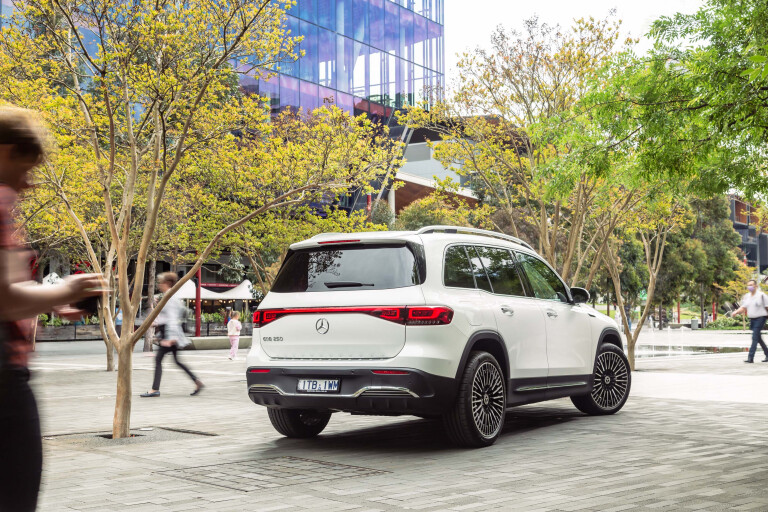
JUMP AHEAD
- How much is it and what do you get?
- How do rivals compare on value?
- Interior comfort & storage
- What’s it like to drive?
- Charging, warranty and running costs
- VERDICT
- Specifications
How much is it and what do you get?
There are two variants of the EQB to choose from: a single-motor EQB 250 which starts at $87,800, or a more powerful twin-motor EQB 350 from $106,700.
Both cars use the same 66kWh battery pack nestled between the axles and their claimed WLTP driving ranges are similar at 371km for the EQB 250 and 360km for the more muscular EQB 350.
The level of standard equipment is also high across both models and includes a comprehensive active safety suite, heated front seats, multi-function leather steering wheel, dual zone climate control, a wireless charging pad and wired Apple CarPlay and Android Auto.
2023 Mercedes-Benz EQB specs: The basics
| EQB250 | EQB350 | |
|---|---|---|
| Body | 5 door, 7-seat SUV | 5 door, 5-seat SUV |
| Drive | Front-wheel drive | All-wheel drive |
| Driving range | 371km | 360km |
| Battery size | 66.5kWh | 66.5kWh |
| Charging speed (DC) | 100kW, 10-80% 30min | 100kW, 10-80% 30min |
| Power & torque | 140kW / 385Nm | 215kW / 520Nm |
| 0-100km/h | 8.9sec (claimed) | 6.5sec (claimed) |
| Boot min / max | 495L / 1710L | 495L / 1710L |
| Price | $87,800 +ORC | $106,700 +ORC |
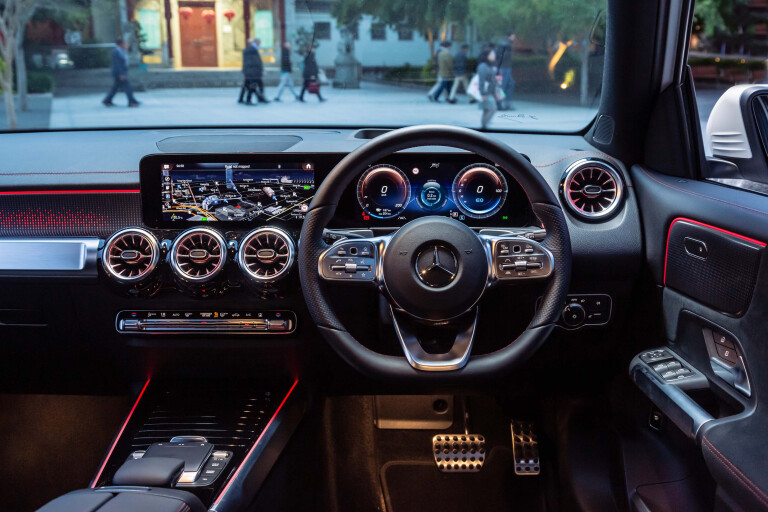
Safety equipment table
| 9 airbags |
| Autonomous emergency braking |
| Lane-keep assist |
| Lane departure warning |
| Adaptive cruise control |
| Blind-spot detection |
| Rear-cross traffic alert |
| 360 degree camera |
The EQB 350 adds an additional electric motor and a host of other equipment upgrades to help justify its circa-$19,000 price premium, like larger 20-inch wheels (250s roll on 19s as standard), a panoramic sunroof, flat bottom steering wheel, sportier front seats and AMG exterior styling with additional chrome trim.
One key differentiator, however, is you can only option the third row of seats on the less powerful EQB 250. Fitting the extra motor onto the rear axle in the 350 means the additional seats won’t fit.
The more expensive 350 also misses out on the 250’s sliding second row which can move 140mm fore and aft to vary luggage capacity and passenger room. So if space and interior flexibility are top priorities, this is one of those rare cases where spending less actually nets you more in some areas.
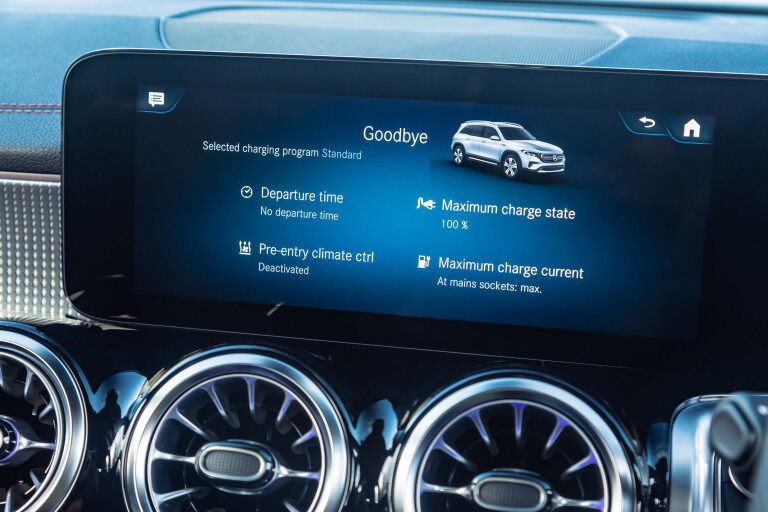
The rest of the EQB’s layout is neatly packaged. Dimensionally it’s very close to a regular GLB (although length has grown by 50mm and it’s 9mm taller) so you score a form factor that’s long, tall and narrow.
That makes it easier to drive in the city than most seven seaters – it’s actually surprisingly wieldy in tight spaces – and it also means it’s a doddle to transport long items like surf boards and bikes when you lie the rear seats flat.
Visually, Merc’s design team has given the EQB some unique touches to distinguish it from the GLB upon which it’s based.
There’s a unique grille and front bumper and because there’s no engine that needs to suck in cool air, most of the vents on the nose have been blanked off which helps to reduce drag to 0.28Cd rather than 0.30 in the GLB.

LED headlights are standard on both models and are joined by a continuous light strip that runs along the top of the grille, which is a Mercedes EV trademark.
The rear lighting signature also runs full width and if you’re looking for a quick way to distinguish the EQB, zero in on the location of the number plate. On the GLB it’s smack bang in the centre of the tailgate but on the EQB it’s been dropped onto the redesigned rear bumper.
Buyers have the choice of nine exterior colours, although only Polar White and Night Black don’t require you to spend more. Every other hue commands a $1490 additional charge, except for grey Magno which costs $3300.

A number of options are available but one pack worth considering is the Innovations Pack for $2500.
It adds a head up display and ‘interior assistant’ functionality to the MBUX infotainment system that adds gesture control and can automatically switch on the map lighting if you reach over to the passenger seat for example.
An Edition 1 pack will also be an option for a limited time and costs $9100 on the 250 or $3900 on the EQB 350. It adds a host of rose gold visual touches, including 20-inch rose gold wheels, black exterior trim and a grey leather interior with blue stitching.
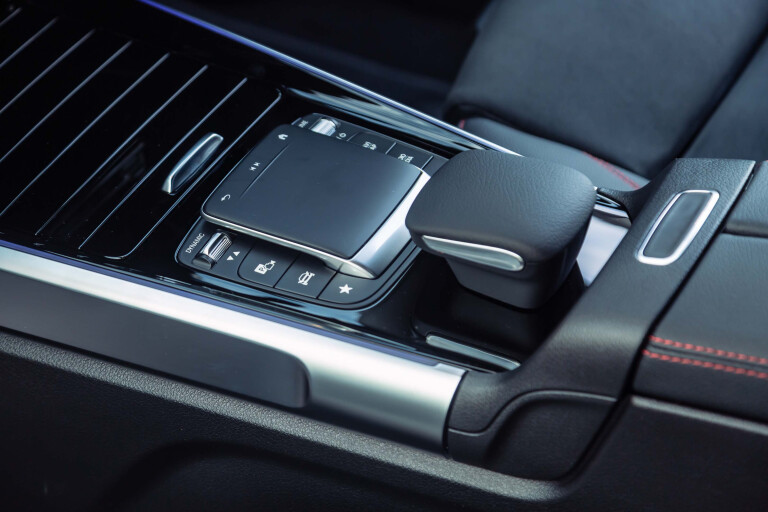
How do rivals compare on value?
This is where the EQB’s value equation goes a touch pear-shaped.
Compared with an equivalent petrol-powered GLB, the EQB is about $9000 more expensive but an EV commanding a price premium over an internal combustion model is nothing new, right?
Where the EQB starts to look a little costly is when you measure it against the Tesla Model Y and Hyundai Ioniq 5.
The Tesla Model Y starts at $72,300 for the rear-drive version which is a sizeable $15,500 saving compared with the EQB 250. The Tesla’s also 150kg lighter, two seconds quicker to 100km/h (6.9sec compared to the EQB 250’s 8.9sec claim) and, despite having a smaller battery pack than the Merc, it trumps it for range by 84km thanks to a 455km WLTP rating.
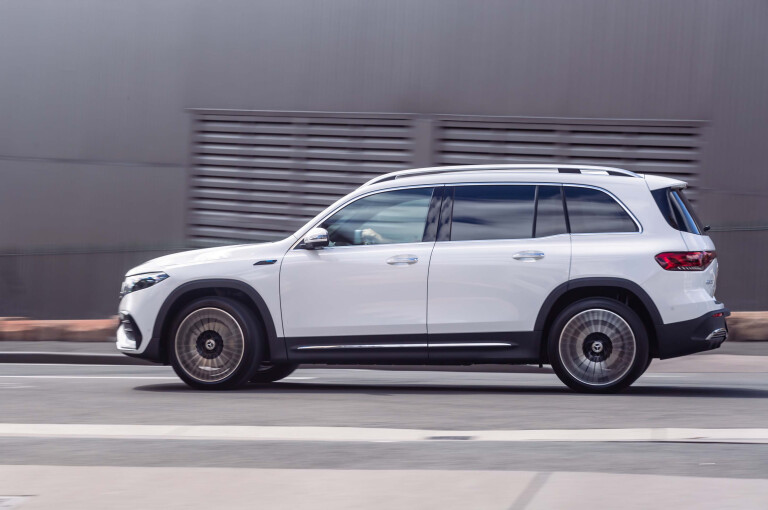
It’s a similar story when you compare the EQB with the Hyundai Ioniq 5 and Kia EV6. The Korean twins are less of a direct rival given they’re crossovers not boxy SUVs, but they’re still similarly sized, offer richly equipped and roomy cabins and gazump the Merc for value, range and performance.
They’re also built on a dedicated EV platform and their charging times are substantially quicker thanks to their 800-volt architecture which can accept higher charging rates.
Still, none of these competitors can seat seven passengers. That’s a clear EQB advantage.
Mini match-up
| Mercedes EQB250 | Mercedes EQB350 | Tesla Model Y RWD | Hyundai Ioniq 5 RWD | VW ID4 Pro Perf | |
|---|---|---|---|---|---|
| Price | $87,800 | $106,700 +ORC | $72,300 | $69,900 | $65,000 (estimate) |
| Power/torque | 140kW/385Nm | 215kW / 520Nm | 220kW/400Nm (est) | 160kW/350Nm | 150kW/310Nm |
| Battery size | 66kWh | 66kWh | 62.3kWh (est) | 72.6kWh | 77kWh |
| Charging speed (max) (DC) | 100kW, 10-80% 30min | 100kW, 10-80% 30min | 250kW, 10-80% 30min* | 350kW, 10-80% 18min | 150kW, 10-80% 33min* |
| Range (WLTP) | 371km | 360km | 455km | 481km | 520km |
| 0-100km/h | 8.9sec | 6.5sec | 6.9sec | 7.4sec | 8.5sec |
| Weight | 2059kg | 2163kg | 1909kg | 1990kg | 2068kg |
* Charging speeds for the Tesla Model Y and VW ID4 are based on estimated information published to the EV Database.
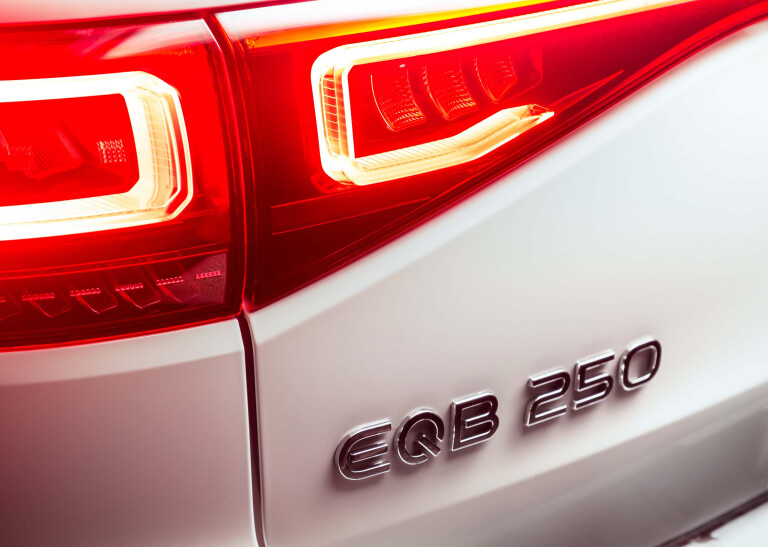
Interior comfort & storage
If you’ve sat in a regular GLB or a Mercedes-Benz A-Class then the cabin of the EQB will be very familiar.
You score the same impressive digital dash that combines two 10.25-inch screens, the same turbine-like air vents and Merc’s MBUX infotainment software which adds features like ‘Hey Mercedes’ voice control is also standard across both variants.

The general cabin ambience is similar across both versions, too. The cabin design and mix of materials feel glitzy and premium, the seats are comfortable and there’s loads of storage thanks to a deep central console, a big glovebox and large door bins.
Start to interact with the interior, though, and some of the initial glamour starts to fade.
The plastics around the air vents and indicator stalks feel a touch thin and flimsy which erodes the sense of quality a little and despite the fact both front seats are heated there’s no electric adjustment for either passenger.

Manually adjustable seats on a circa-$100K SUV feels a touch stingy, but here’s hoping it’s a semiconductor issue and electric seats return in the future.
Still, the EQB nails the basics when it comes to space and comfort. Vision out is excellent and there’s ample knee- toe- and headroom for adults in the second row. Low window sills further improve visibility for kids in the back seat and there are two rear air vents, too, although there’s no individual temperature control.
Other amenities include a centre armrest with twin cupholders and map pockets but there’s only one USB-C charger in the back seat which could be an issue if both kids needs to charge an iPad. There are another two USB-C outlets inside the rear of the front centre console, however, which will help prevent WWIII.
As for the EQB’s unique selling point of a third row of seats? They aren’t exactly roomy.
Even Mercedes says they’re best suited for passengers shorter than 165cm, but we did fit three adults behind one another in all three rows without too much trouble. (We'll add a photo soon.)
Headroom is the biggest issue in the third row but it’s fine for short journeys and each passenger does score their own USB-C charging point. There are two extra Isofix anchor points, too, plus the curtain airbags extend into the third row so you can put little kids in the very back, providing you’re willing to lean through to strap them in properly.
One thing you lose if you option the third row is boot space. An electric tailgate is standard across the range, and five-seat versions of the EQB offer a 495L boot with the rear seats up and 1710L of capacity with the second row laid flat.
Option the third row of seats, however, and those figures drop to 465L and 1620L. Seven seat versions also lose a big chunk of under floor storage which is useful to store the charging cables.
Elsewhere in the boot there are some netted sections for smaller items and a parcel shelf but, like a lot of EVs, there’s no spare tyre. Just a can of goo and a compressor.

What’s it like to drive?
This is where the EQB stands head and shoulders above the SUV it’s based on. Where a regular GLB can feel a touch firm and stiff legged over bumps, the EQB’s chassis is far more polished.
Adaptive dampers are standard in both models and the suspension is quite softly set-up so there’s decent compliance to enjoy even on the EQB 350’s 20-inch alloys.
Body roll is nicely contained, too, and while it’s no hot hatch, throw the EQB at a challenging section of road and it’s more fun and composed than you’d expect a big, tall family SUV to be. Especially one that weighs more than two tonnes.
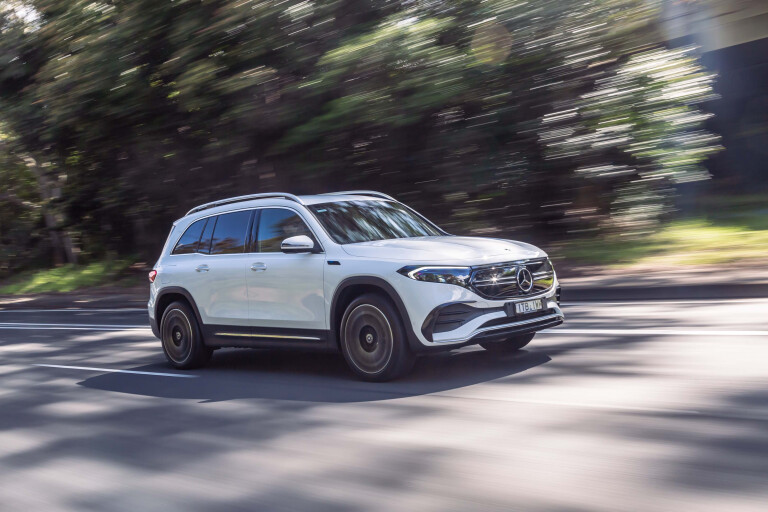
There’s also ample performance to exploit, despite the hefty kerb weight. Single motor versions offer 140kW/385Nm while the twin-motor EQB 350 has 215kW/520Nm at its disposal.
Weirdly, given the 350’s on-paper performance advantage, there’s actually not a huge difference when it comes to step-off acceleration and nippiness in city traffic.
Where you do notice the 350’s extra oomph is on the open road. Its roll-on acceleration is more potent and its overtaking performance in particular is considerably stronger. It’s just as quick as Mercedes claims, too. On a wet road we clocked the EQB 350 at 6.5sec from 0-100km/h, which is only two tenths away from the official claim in ideal conditions.
Traction is both variants is impressive. It was raining hard during our time with the EQB but even on slippy surfaces and under full throttle applications there was very little wheelspin or torque steer, which is an issue that can plague other electric cars.
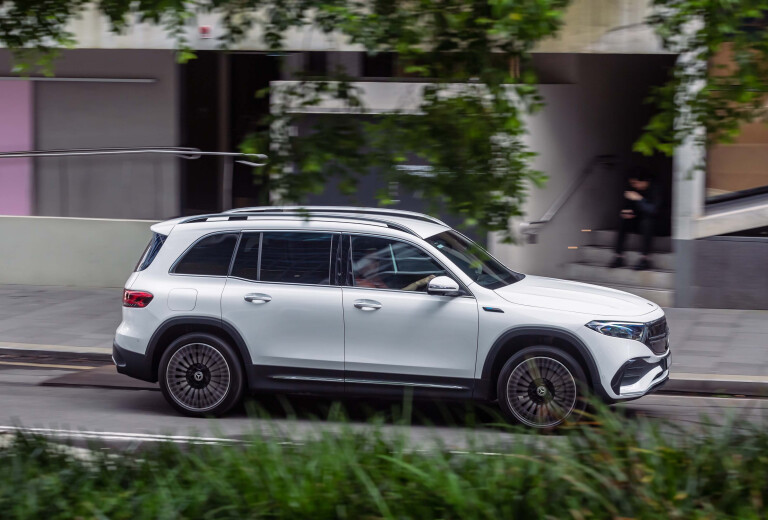
There are four stages of regenerative braking to play with. The default setting is D which offers some resistance when you lift off the throttle, but if you pull the right paddle behind the steering wheel you’ll engage D+ which slackens off the regen and allows you to coast as though you’re in a petrol car with the clutch pushed in.
Pulling the left shift paddle lets you engage D- which is the strongest regen setting. It won’t bring the EQB to a complete stop but it’s strong enough that it gets pretty close to one pedal driving in heavy traffic.
Throw in steering that’s naturally weighted and accurate and there are very few chinks in the EQB’s armour when it comes to how it goes, stops and steers. We doubt most owners will ever fully exploit the tidy handling but it’s nice to know the EQB is up to the task if you’re a keen driver.
A dynamic overachiever? Wasn’t expecting that.
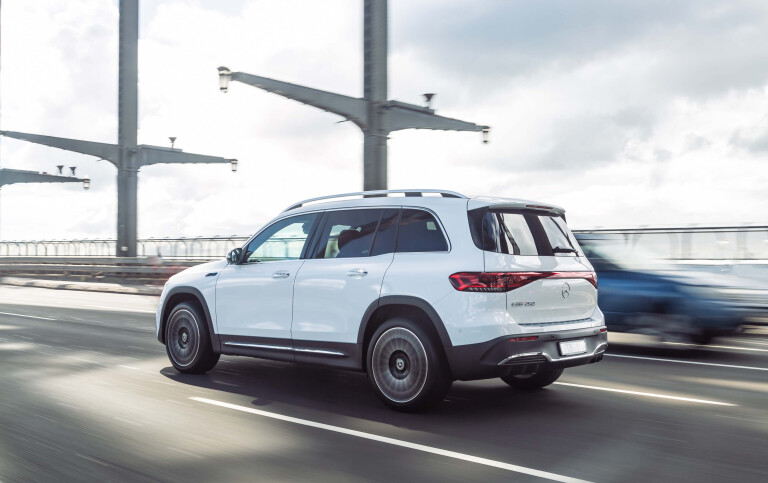
Charging, warranty and running costs
Like most EVs, the EQB accepts both AC charging from a regular socket or wall box, and DC charging from a fast charger.
If you plug the EQB into a regular socket it will take around 25 hours to charge but if you have three phase power at home and an 11kW wall box you can fill up your battery in around 6.5 hours.
As for DC charging, the EQB accepts up to 100kW so you can go from 10-80 percent battery charge in half an hour. Don’t have quite that long? Just 15 minutes on a DC charger will net you about 150km of range.
Servicing intervals are every 12 months/25,000km and Mercedes offers fixed price servicing plans that averages each visit to the dealer out to around $550. A three year plan is $1625, four years is $2225 while five years of servicing will set you back $2650.
Like the rest of the Mercedes range, the EQB is covered by a five year/unlimited km warranty. The battery itself is covered by a separate 10-year/250,000km warranty.
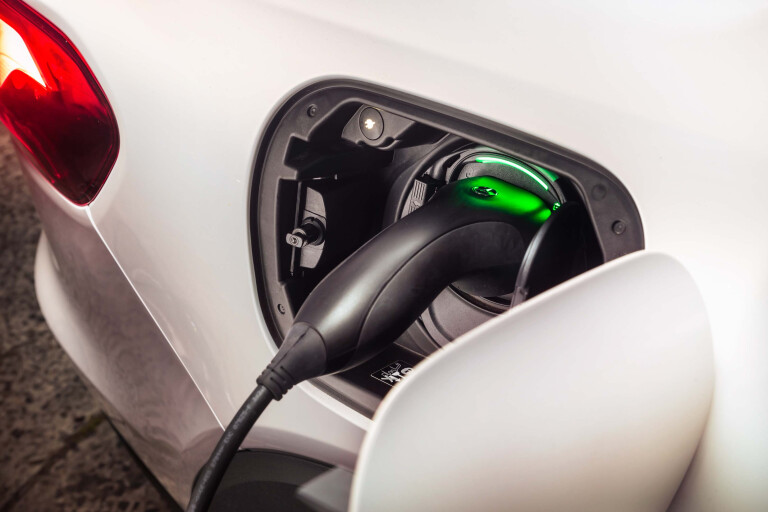
VERDICT
In isolation, the EQB is a convincing thing. It’s better to drive than a regular GLB, there’s lot to like about the rich standard specification and the practicality of its tall and narrow form factor but its real advantage is the fact it offers seven seats.
That the extra pews are only available on the cheaper EQB 250 mounts a convincing case that it’s actually the variant to buy given the equipment and performance leap up to the 350 isn’t actually that big.
But there’s no escaping that in several areas the EQB isn’t as compelling as its key rivals. A Tesla Model Y and Hyundai Ioniq 5 are better value and offer more performance and more range.
But if you need seven seats and you’re drawn to the polished dynamics and silent surge of its electric powertrain, it’s also clear the EQB is one of the most persuasive models yet to be spun off the MFA2 platform.
2023 Mercedes-Benz EQB specifications
| EQB250 | EQB350 | |
|---|---|---|
| Body | 5 door, 7-seat SUV | 5 door, 5-seat SUV |
| Drive | Front-wheel drive | All-wheel drive |
| Battery size | 66.5kWh | 66.5kWh |
| Charging speed (DC) | 100kW, 10-80% 30min | |
| Power | 140kW | 215kW |
| Torque | 385Nm | 520Nm |
| 0-100km/h | 8.9sec (claimed) | 6.5sec (claimed) |
| Transmission | Single-speed reduction | Single-speed reduction |
| Weight | 2059kg | 2163kg |
| Front suspension | MacPherson struts, coil springs, adaptive dampers, anti-roll bar | |
| Rear suspension | Multi-links, coil springs, adaptive dampers, anti-roll bar | |
| L/W/H | 4684/1834/1701mm | |
| Wheelbase | 2829mm | |
| Brakes | Ventilated discs (f), 4 x regen settings | |
| Tyres | 235/45 R20 Pirelli PZero | |
| Wheels | 20-inch alloy | |
| Price | $87,800 +ORC | $106,700 +ORC |
Score breakdown
Things we like
- The only 7-seat electric car you can buy
- Comfortable ride & polished dynamics
- Superior to drive than the GLB on which it’s based
Not so much
- More expensive, slower and has less range than rivals
- 5 seat versions lose sliding second row
- Sub-par cabin plastics & no electric seats feel stingy at this price


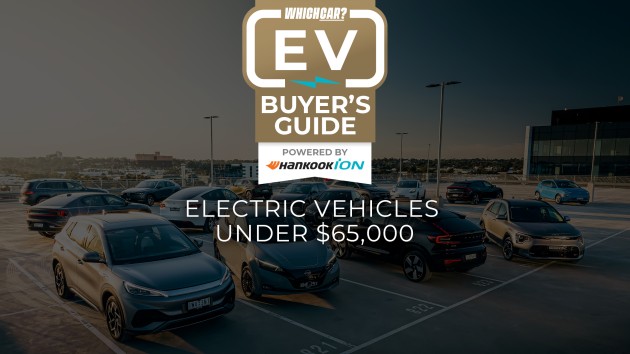


COMMENTS